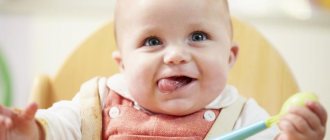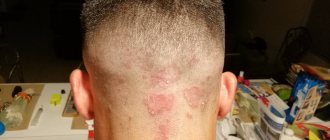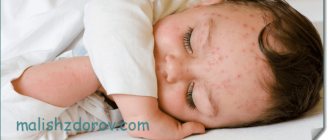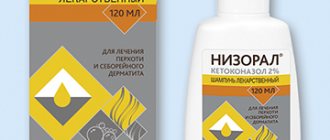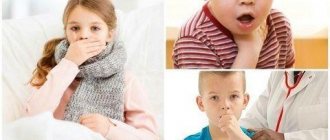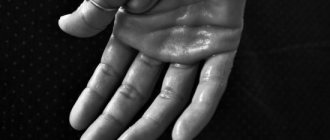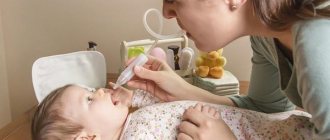Dermatovenerologist (1 KO, 1/35)
Kintaev
Azamat Samuratovich
8 years of experience
Dermatovenerologist
Make an appointment
Ringworm (microsporia) is a disease manifested as a fungal infection of the skin, nail plates and hair follicles. The pathogen is a mold fungus of the genus Microsporum. Its colonies form in keratinized substrates. Microsporia remains a relatively common disease - dermatologists identify 60-75 cases for every hundred thousand Moscow residents. The pathology has a pronounced seasonality. The peak incidence occurs at the end of summer and beginning of autumn - the period of breeding of offspring in cats and other animals.
What does ringworm look like?
If you look at a photo of lichen in children, you will notice that it has the same appearance as in adults. Often simply in a weaker reaction. This means that the reasons for its appearance are absolutely the same as in adults.
Most often, lichen is presented in the form of round spots on the body, the skin on which dries out and begins to peel off severely. They can reach five centimeters in diameter, and the process is often accompanied by irritating sensations, such as itching or even mild pain.
Ringworm most severely affects exposed parts of the body, such as the lower back, abdomen, hips, shoulders, chest, back, and arms.
What are the methods of infection?
Carriers of this disease are both sick people and animals. Most often, stray dogs or cats act as carriers. Puppies and kittens are especially often affected. However, in animals, due to physiology, this disease proceeds much simpler and faster, without greatly affecting the state of health.
The cause of infection may well be another person. Infection can occur through communication or the use of personal hygiene items, such as a towel or comb. The likelihood of the disease increases several times if a person has some lesions or abrasions of the skin, as well as if he has a weakened immune system.
Ringworm on the face
It is especially difficult for a child to experience the appearance of lichen on the surface of the face. This is often accompanied by severe stress and constant psychological pressure caused by flaws in appearance, even if temporary. At this time, you need to understand not only how to identify lichen in a child, but also how to communicate with him at this time.
It is important to explain that there is nothing wrong with this, and that the skin defect will pass, and therefore there is no need to feel worse than the children around you.
The psychological state plays an important role, because under the influence of severe stress the child’s immunity can weaken, which will only intensify the inflammatory reaction from lichen.
Questions to ask your doctor
- Do I really have tinea pilaris?
- For what reasons did I develop this disease?
- Which treatment option is optimal in my case?
- What lotion do you recommend for me?
- Do I need to use humidifiers?
- Will my condition improve during the summer months?
- Can pilaris go away with age?
- In what cases should you seek help if your health worsens?
- Do I need to make lifestyle changes?
- Do I need any prescription medications?
( 1 votes, average: 5.00 out of 5)
Loading…
Causes of lichen
To understand how and how to treat lichen for children, you need to understand the sources of the problem. Ringworm appears as a result of a certain type of virus coming into contact with the skin.
This happens from the simplest contact, direct or indirect. You can get infected not only from other people, but also from animals.
Particularly dangerous in this regard are stray animals that do not have medical supervision and care. Among them, lichen spreads quite quickly, which is why many people, including children, can become infected.
Weak immunity can cause infection. In many cases, minimal contact may not pose a threat because the body's immune system quickly copes with the virus. After a cold or serious illness, a child’s body can become very weak, making him more susceptible to external threats.
Here you can add allergies, increased sweating during hot periods of the year, physical damage to the upper layers of the skin and much more.
Types of lichen
If you suspect lichen in a child, you should consult a dermatologist as soon as possible. He will be able to give you good advice on how to properly treat lichen, immediately after he determines its type and cause.
There are six common types of lichen - ringworm, vermilion, tinea versicolor, versicolor, pink and scaly.
All these types have a number of features, which consist both in appearance and in the symptoms that accompany them. In addition, the type of treatment may differ, as well as medications and ointments for lichen. Next, we will look at some of the most frequently encountered types in a little more detail.
Folk remedies
How to treat lichen on the head in children? Various decoctions, tinctures, lotions and ointments are used:
- Mix beetroot broth with honey (1:1) and lubricate all affected areas. It is not recommended to wash off this mixture.
- Apply garlic and onion pulp, wrapped in a gauze bandage, to the inflamed skin. You should be careful not to let it come into contact with healthy areas of the body.
- Apply the ringworm with a warm mixture prepared from a small amount of hot sulfur (yellow) with olive oil. This procedure is carried out until the sore disappears completely.
- Mix radish pulp with bee honey (1:1) and treat the inflamed areas.
- To get rid of lichen in a baby, you should pour medicinal chamomile with boiling water, cool and rub into the inflamed areas until the disease completely goes away. The duration of this treatment does not exceed several weeks.
Depending on what the lichen on the head looks like in children, it is treated in the following ways:
- In addition to treating the disease itself, the child’s immune system is increased and the body is strengthened.
- You can also finely chop the cabbage and add sour cream, and make such lotions several times a day.
- Many special decoctions can be taken internally, for example, based on celandine, calendula, licorice root and some other plants. To do this, the components are brewed in the usual way: a tablespoon of raw material is poured with boiling water and infused in a dark place for several hours.
- If the lichen is extensive, it is recommended to take special medicinal baths. 100 grams of the medicinal mixture are brewed in a water bath and baths are prepared. It is recommended to take within half an hour.
- If the rashes are severe, then it is advisable to mix St. John's wort, string and chamomile, add boiling water and leave in a dark place for about an hour. Rinse your hair with this solution.
It is advisable to wash your child’s hair with shampoos and conditioners, which are based only on natural products.
- Take 50 grams of honey and fill it with 200 grams of alcohol, then close the lid and leave for several days in a dark place. Then it is recommended to treat the inflamed areas well.
- To make the disease go away from the hair, it is recommended to take a small chicken egg. Separate the white from the yolk and coat the sores with the white, apply cellophane and wrap with a sterile bandage. The effect will be noticed in a few days.
- Black raisins are also used to treat lichen. To make a special medicinal ointment, it is recommended to grind steamed raisins and lubricate the inflamed areas. At the same time, they drink various medicinal decoctions.
It is recommended to enrich shampoos with essential oils based on olives and avocados, as well as rose petals. Some experts advise making a compress with yeast dough. To do this, it is applied to the lichen and kept for several hours. The disease goes away within a few weeks.
You can soak the washed peas in water for a few minutes and then boil them. After it has cooled, lubricate all affected areas for the baby. Thanks to this procedure, you can quickly get rid of skin peeling and itching.
You can also crush cranberries or viburnum (1:1) and lubricate the affected areas for the child (repeat several times a day). Thanks to this procedure, you can forget about the disease in a few weeks.
Pityriasis rosea
This lichen received its second name in honor of Gibert, the Frenchman who discovered it. It poses a threat to children aged five to twelve years. It is considered quite dangerous because it is very easily and quickly transmitted between children.
First, a small pink spot appears and begins to peel off. After this, a rash begins to appear around him, which spreads in all directions. This is accompanied by quite severe itching, due to which children often scratch the affected areas until they bleed, which is very dangerous.
Ringworm
It got this name for a reason, because most often it appears in the hair on the head. As soon as you discover it, you must immediately begin to think about how to quickly and easily cure this type of lichen for your child. A timely response is important.
The fact is that if you don’t pay attention to it and neglect it a little, you can lose some of the hair on your head until the problem is fixed.
The source is a fungus that undergoes an incubation period in the body for two weeks. After this, the first symptoms begin to appear on the scalp, arms, torso and other parts of the body.
At this time, the skin gradually begins to peel off, which eventually turns into an active state. It is often transmitted from animals suffering from this lichen.
Diagnostic methods
First of all, the doctor conducts a survey to find out the main complaints and the expected source of infection (contact with sick people, animals). Then the lesion site is inspected and samples are taken, which are examined under a microscope.
- Microscopic examination of mushrooms allows you to see the presence of mycelium. However, this method cannot determine which fungus is causing the disease.
- A cultural study involves inoculating material taken from a patient onto a special nutrient medium. This technique allows you to accurately identify the pathogen.
- Fluorescence method in Wood's rays (long-wave ultraviolet radiation, which is used in dermatology for diagnosis). With fungal infections, an emerald green glow of the lesions is observed.
- Additional methods (blood and urine tests are done every 10 days if antifungal drugs are used orally). The purpose of these studies is to monitor the general condition of the body during the period of antifungal therapy.
Alternative Treatment
We all know that there are many folk remedies and recipes for lichen that our ancestors actively practiced. However, it is worth understanding that in this case we are talking about the health of the child. In such a situation, it is better to contact a dermatologist in a timely manner, who will prescribe the correct treatment and rehabilitation.
